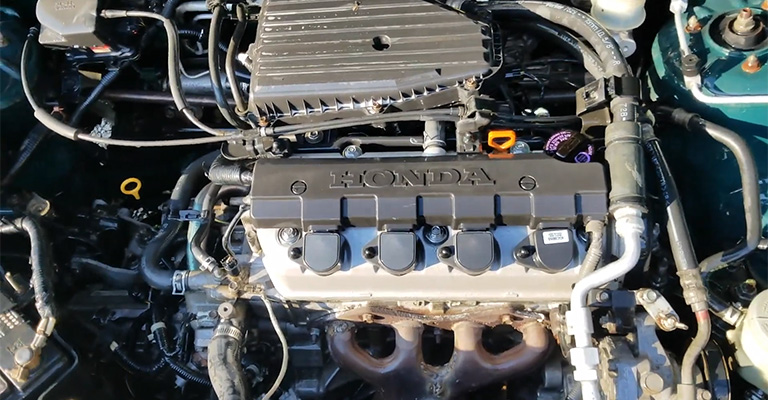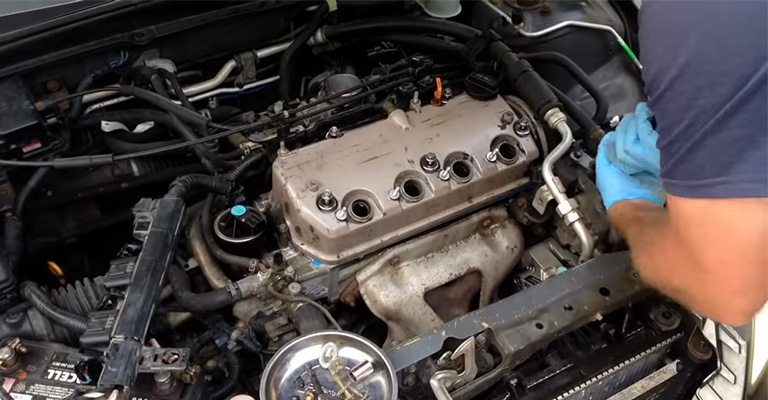The Honda D17A1 engine is a 1.7-liter inline 4-cylinder engine that was produced by Honda and used in various models of the Honda Civic.
This engine was primarily used in the 2001-2005 Honda Civic DX, LX, and VP models.
The D17A1 engine was designed to provide a balance of power, fuel efficiency, and reliability, making it a popular choice among Honda enthusiasts.
In this blog post, we will take a closer look at the specs and performance of the D17A1 engine, as well as its reliability and durability.

Honda D17A1 Engine Overview
The Honda D17A1 engine is a 1.7-liter inline 4-cylinder engine that was produced by Honda and used in various models of the Honda Civic.
One of the key features of the D17A1 engine is its displacement of 1,668 cc or 101.8 cubic inches. The bore and stroke of the engine are 75 mm x 94.4 mm, and it has a compression ratio of 9.5:1.
The D17A1 engine uses a Single Overhead Cam (SOHC) valvetrain, which means that there is only one camshaft that operates the valves.
This design is simpler and more compact than a Dual Overhead Cam (DOHC) valvetrain, but it also means that there are fewer valves per cylinder.
The D17A1 engine has four valves per cylinder, which is still enough to provide good airflow and power.
The D17A1 engine uses OBD-2 MPFI (Multi-Point Fuel Injection) for its fuel delivery system. This system uses multiple fuel injectors to deliver fuel into the intake manifold, which is more efficient and precise than older carburetor systems.
The OBD-2 part of the system refers to the engine’s onboard diagnostic system, which makes it easier to diagnose and troubleshoot any issues that may arise.
In terms of performance, the D17A1 engine is considered to be a solid performer. It provides a good balance of power and fuel efficiency, making it a great choice for daily driving.
The engine’s redline is high enough to provide plenty of fun when revved out, but it’s not so high that it becomes unreliable.
The D17A1 engine is also popular among Honda enthusiasts as it is known to be a great platform for modifications and upgrades.
With proper maintenance and service, the D17A1 engine can be expected to provide reliable and durable performance for many years to come.

Specification Table for D17A1 Engine
| Specification | Value |
| Displacement | 1,668 cc (101.8 cu in) |
| Bore x Stroke | 75 mm x 94.4 mm (2.95 in x 3.72 in) |
| Compression Ratio | 9.5:1 |
| Power Output | 122 hp (85.8 kW, 124 ps) at 6400 RPM |
| Torque Output | 110 lb-ft (15.2 kg/m, 149 Nm) at 4500 RPM |
| RPM Redline | 6750 RPM |
| Rev-Limiter | 7200 RPM |
| Valvetrain | SOHC, 4 valves per cylinder |
| Fuel Control | OBD-2 MPFI |
Note: The above table is providing the general specifications of the D17A1 engine, it may vary depending on the model and year of the car.
Source: Wikipedia
Comparison With Other D16 Family Engines
The D17A1 engine is part of the D16 engine family, which includes a variety of other Honda engines that share similar characteristics and specs.
Some of the most notable engines in the D16 family include
- D16Y7: This is a 1.6-liter engine that was used in the 1996-2000 Honda Civic DX, LX, and CX models. It has a power output of 106 horsepower and 103 lb-ft of torque and a compression ratio of 9.2:1.
- D16Y8: This is another 1.6-liter engine that was used in the 1996-2000 Honda Civic EX models. It has a power output of 127 horsepower and 107 lb-ft of torque and a compression ratio of 9.6:1.
- D16A6: This is a 1.6-liter engine that was used in the 1988-1991 Honda Civic DX, LX, and Si models. It has a power output of 92 horsepower and 92 lb-ft of torque and a compression ratio of 8.8:1.
Compared to these other D16 engines, the D17A1 has a larger displacement, a higher compression ratio, and more horsepower and torque.
It also uses OBD-2 MPFI, while the other engines use OBD-1 MPFI. This means that the D17A1 is generally considered to be more powerful and efficient than the other D16 engines.
The D17A1 is a great upgrade for the D16 engines, however, it is important to remember that the D17A1 is not a direct swap for the D16 engines, as the engine mounts and the transmission are different.
The D17A1 is a great engine for those looking for more power and efficiency, but it is not a direct swap for the other D16 engines.
What Car Did the D17A1 Come in?
The D17A1 engine was primarily used in 2001-2005 Honda Civic DX, LX, and VP models. These were compact cars manufactured by Honda that came in different body styles such as Sedan, Coupe, and Hatchback.
This engine was known for its balance of power, fuel efficiency, and reliability, making it a popular choice among Honda enthusiasts.
What Are the Issues and Problems With Honda D17A1 Engine
The Honda D17A1 engine, which is found in 2001-2005 Honda Civics, is known for several issues and problems. Some common issues include
1. Timing Chain Tensioner Failure
The timing chain tensioner is known to fail on these engines, which can cause the timing chain to jump and cause damage to the engine.
2. Oil Leaks
The D17A1 engine is known to develop oil leaks, particularly from the valve cover gasket and the oil pan gasket.
3. Oil Consumption
Some D17A1 engines may consume oil at an excessive rate.
4. Valve Tap
The valve lifters may develop a tap or ticking noise, which can be caused by a lack of oil pressure or clogged oil passages.
5. Cylinder Head Warp
The cylinder head may warp due to overheating, which can cause poor compression and engine performance issues.
6. Oil Pressure Switch Failure
The oil pressure switch is known to fail, which can cause the oil pressure warning light to come on.
It is important to note that not all D17A1 engines will have these issues, but they have been reported by a significant number of D17A1 owners. Regular maintenance and proper care can help prevent or minimize these issues.
Upgrades and Modifications for Honda D17A1 Engine
The Honda D17A1 engine is a popular choice among Honda Civic enthusiasts. However, it is not a high-performance engine and is not well suited for drag racing or high-powered road racing.
Some possible upgrades and modifications for the D17A1 engine include:
1. Cold air intake
This helps to increase airflow to the engine, resulting in a small horsepower boost.
2. Exhaust system
A high-performance exhaust system can help to improve the engine’s breathing, resulting in more horsepower and torque.
This can be done through a programmable engine management system (EMS) or a piggyback system. These systems allow for fine-tuning of the engine’s fuel and timing settings, resulting in more power.
3. Engine tuning
4. Suspension
Upgrading the suspension can help to improve handling and stability, allowing for better performance on the track.
5. Lightweight wheels and tires
Lighter wheels and tires can help to improve the car’s acceleration and braking.
It is worth noting that, while these modifications can improve the performance of your D17A1 engine, they will not turn it into a high-performance powerhouse.
If you’re looking to build a high-performance car, you may want to consider starting with a different engine or platform.
Other D Series Engines-

Leave a Reply